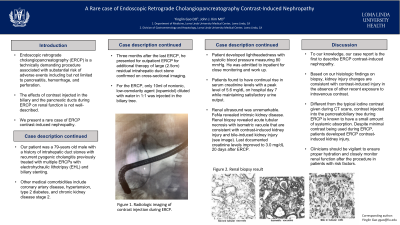Sunday Poster Session
Category: Interventional Endoscopy
P0897 - Case Report: A Case of Endoscopic Retrograde Cholangiopancreatography Contrast-Induced Nephropathy
Sunday, October 22, 2023
3:30 PM - 7:00 PM PT
Location: Exhibit Hall

Has Audio
- YG
Yinglin Gao, DO
Loma Linda University Health
Loma Linda, CA
Presenting Author(s)
Yinglin Gao, DO, John J. Kim, MD, MS
Loma Linda University Health, Loma Linda, CA
Introduction: Endoscopic retrograde cholangiopancreatography (ERCP) is a technically demanding procedure associated with substantial risk of adverse events. Common adverse events include pancreatitis, hemorrhage, and perforation. Water iodine-based contrast media is injected into the biliary and the pancreatic ducts during ERCP. The effects of contrast injected in the biliary and the pancreatic ducts during ERCP on renal function is not well-described. We present a rare case of ERCP contrast-induced nephropathy.
Case Description/Methods: Our patient was a 79-year old male with a history of intrahepatic duct stones with recurrent pyogenic cholangitis previously treated with multiple ERCPs with electrohydraulic lithotripsy (EHL) and biliary stenting. Other medical comorbidities include coronary artery disease, hypertension, type 2 diabetes, and chronic kidney disease stage 2. Three months after the last ERCP, he presented for outpatient ERCP for additional therapy of large (2.5cm) residual intrahepatic duct stone confirmed on cross-sectional imaging. For the ERCP, only 10ml of nonionic, low-osmolarity agent (iopamidol) diluted with water in 1:1 was injected in the biliary tree given history of recurrent pyogenic cholangitis and intrahepatic duct stones. Patient was hospitalized post procedure due to lightheadedness with systolic blood pressure measuring 80 mmHg. After the procedure, patients experienced continual rise in serum creatinine levels with a peak level of 5.6 mg/dL on hospital day 7 while maintaining satisfactory urine output. Renal ultrasound was unremarkable. FeNa revealed intrinsic kidney disease. Renal biopsy revealed acute tubular necrosis with isometric vacuole that are consistent with contrast-induced kidney injury and bile-induced kidney injury (see image). Last documented creatinine levels improved to 3.0 mg/dL 20 days after ERCP.
Discussion: To our knowledge, our case report is the first to describe ERCP contrast-induced nephropathy. Contrast injected into the pancreatobiliary tree during ERCP is known to have a small amount of systemic absorption. Based on our histologic findings on biopsy, kidney injury changes are consistent with contrast-induced injury in the absence of other recent exposure to intravenous contrast. Despite minimal contrast being used during ERCP, patients developed ERCP contrast-induced kidney injury. Clinicians should be vigilant to ensure proper hydration and closely monitor renal function after the procedure in patients with risk factors.

Disclosures:
Yinglin Gao, DO, John J. Kim, MD, MS. P0897 - Case Report: A Case of Endoscopic Retrograde Cholangiopancreatography Contrast-Induced Nephropathy, ACG 2023 Annual Scientific Meeting Abstracts. Vancouver, BC, Canada: American College of Gastroenterology.
Loma Linda University Health, Loma Linda, CA
Introduction: Endoscopic retrograde cholangiopancreatography (ERCP) is a technically demanding procedure associated with substantial risk of adverse events. Common adverse events include pancreatitis, hemorrhage, and perforation. Water iodine-based contrast media is injected into the biliary and the pancreatic ducts during ERCP. The effects of contrast injected in the biliary and the pancreatic ducts during ERCP on renal function is not well-described. We present a rare case of ERCP contrast-induced nephropathy.
Case Description/Methods: Our patient was a 79-year old male with a history of intrahepatic duct stones with recurrent pyogenic cholangitis previously treated with multiple ERCPs with electrohydraulic lithotripsy (EHL) and biliary stenting. Other medical comorbidities include coronary artery disease, hypertension, type 2 diabetes, and chronic kidney disease stage 2. Three months after the last ERCP, he presented for outpatient ERCP for additional therapy of large (2.5cm) residual intrahepatic duct stone confirmed on cross-sectional imaging. For the ERCP, only 10ml of nonionic, low-osmolarity agent (iopamidol) diluted with water in 1:1 was injected in the biliary tree given history of recurrent pyogenic cholangitis and intrahepatic duct stones. Patient was hospitalized post procedure due to lightheadedness with systolic blood pressure measuring 80 mmHg. After the procedure, patients experienced continual rise in serum creatinine levels with a peak level of 5.6 mg/dL on hospital day 7 while maintaining satisfactory urine output. Renal ultrasound was unremarkable. FeNa revealed intrinsic kidney disease. Renal biopsy revealed acute tubular necrosis with isometric vacuole that are consistent with contrast-induced kidney injury and bile-induced kidney injury (see image). Last documented creatinine levels improved to 3.0 mg/dL 20 days after ERCP.
Discussion: To our knowledge, our case report is the first to describe ERCP contrast-induced nephropathy. Contrast injected into the pancreatobiliary tree during ERCP is known to have a small amount of systemic absorption. Based on our histologic findings on biopsy, kidney injury changes are consistent with contrast-induced injury in the absence of other recent exposure to intravenous contrast. Despite minimal contrast being used during ERCP, patients developed ERCP contrast-induced kidney injury. Clinicians should be vigilant to ensure proper hydration and closely monitor renal function after the procedure in patients with risk factors.

Figure: figure1. Microscopic findings of renal biopsy
Disclosures:
Yinglin Gao indicated no relevant financial relationships.
John Kim indicated no relevant financial relationships.
Yinglin Gao, DO, John J. Kim, MD, MS. P0897 - Case Report: A Case of Endoscopic Retrograde Cholangiopancreatography Contrast-Induced Nephropathy, ACG 2023 Annual Scientific Meeting Abstracts. Vancouver, BC, Canada: American College of Gastroenterology.
